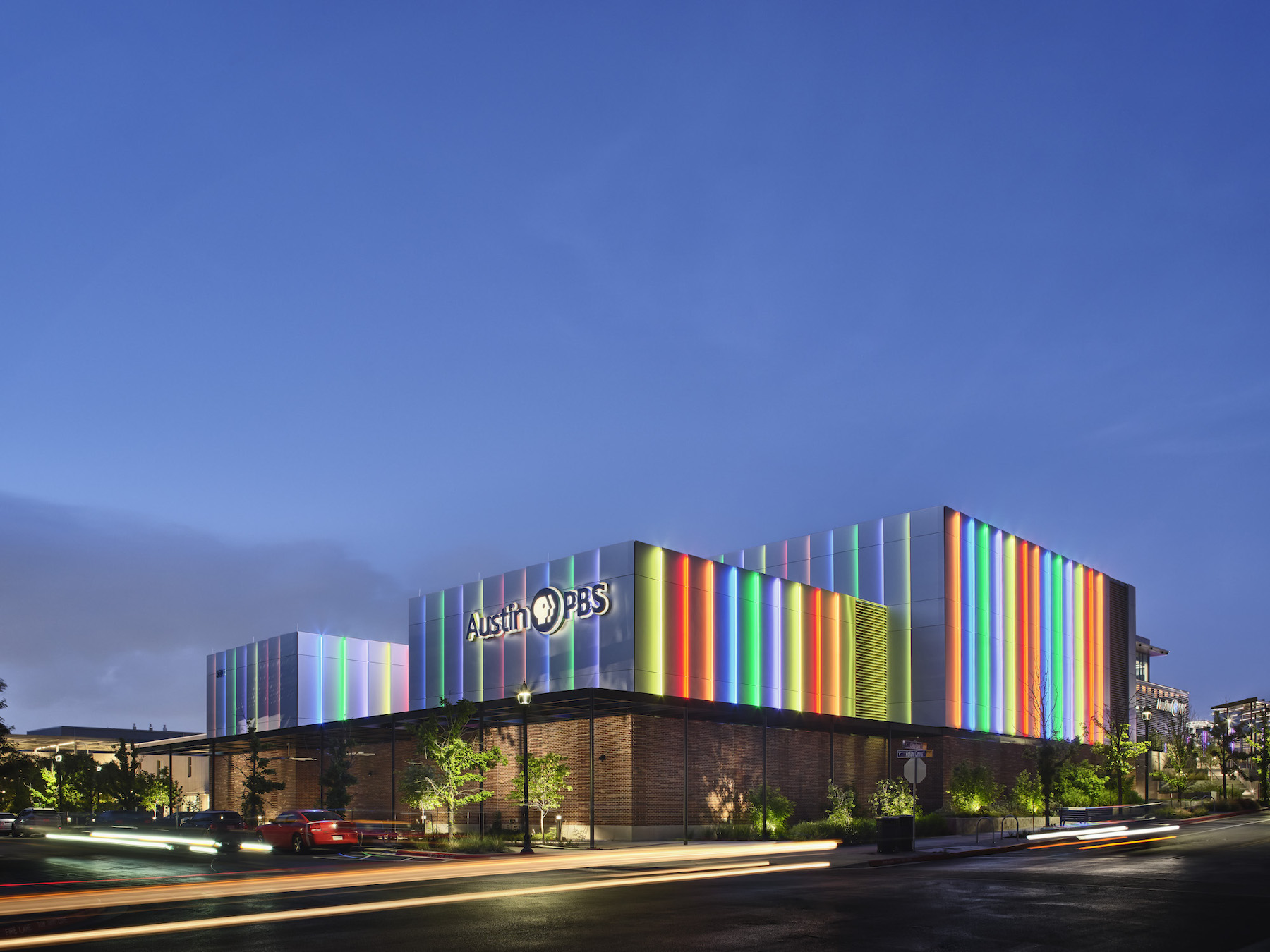Since the 1970s, Austin PBS, birthplace of the Austin City Limits TV series, has been based inside the communications building on the University of Texas campus—a space it has long outgrown. In 2017, the design and planning began for a new state-of-the-art facility located in Austin Community College’s Highland Campus, a former shopping mall.
Designed by Austin architecture firm Studio Steinbomer, the roughly 70,000-square-foot facility, opening this year, has three TV studios. One studio serves as a live audience and community outreach venue. This 6,500-square-foot space has retractable seats and can be reconfigured for live music, town halls, and other productions with live audiences. The other two studios accommodate non-audience programming.
The three studios share walls with workspaces, so the design team placed prime importance on acoustics and sound deadening. The live-audience studio has a floating slab, a silent air conditioner, and highly absorptive materials. So a meeting in the next-door conference room would be undisturbed by a live music performance on the other side of its walls.
Austin PBS’s new home is the first 12-gig digital broadcast network facility for any public television in the US, according to a statement. To highlight the state-of-the art tech, the architects kept much of the 300 miles of cable fully exposed, housing it in custom channels cut out of the ceiling.
A large portion of the building is partially subgrade. So to mitigate the feeling of being underground, the lighting quality mimics skylights and the sun’s movement, creating circadian rhythms that allow people to sense the time by the quality of light. Interior finishes include a mix of bright colors, natural warm wood tones, and nature-simulating colors. And whimsical, industry-specific details include On-Air lights indicating occupied bathrooms.
On the Building Team:
Owner: Austin Community College
Developer: RedLeaf Properties
Design Architect - Exterior: Gensler Austin
Design Architect, Architect of Record - Interiors: Studio Steinbomer (interior remodel level one, and interior of addition)
MEP engineer: Bay & Associates Inc.
Structural engineers: Cardno and Tsen Engineering
General contractor: Rogers-O’Brien Construction
Construction manager: PMA (Project Management Advisors)



Related Stories
| Oct 13, 2010
Community college plans new campus building
Construction is moving along on Hudson County Community College’s North Hudson Campus Center in Union City, N.J. The seven-story, 92,000-sf building will be the first higher education facility in the city.
| Oct 13, 2010
County building aims for the sun, shade
The 187,032-sf East County Hall of Justice in Dublin, Calif., will be oriented to take advantage of daylighting, with exterior sunshades preventing unwanted heat gain and glare. The building is targeting LEED Silver. Strong horizontal massing helps both buildings better match their low-rise and residential neighbors.
| Oct 12, 2010
Holton Career and Resource Center, Durham, N.C.
27th Annual Reconstruction Awards—Special Recognition. Early in the current decade, violence within the community of Northeast Central Durham, N.C., escalated to the point where school safety officers at Holton Junior High School feared for their own safety. The school eventually closed and the property sat vacant for five years.
| Oct 12, 2010
Guardian Building, Detroit, Mich.
27th Annual Reconstruction Awards—Special Recognition. The relocation and consolidation of hundreds of employees from seven departments of Wayne County, Mich., into the historic Guardian Building in downtown Detroit is a refreshing tale of smart government planning and clever financial management that will benefit taxpayers in the economically distressed region for years to come.
| Oct 12, 2010
Owen Hall, Michigan State University, East Lansing, Mich.
27th Annual Reconstruction Awards—Silver Award. Officials at Michigan State University’s East Lansing Campus were concerned that Owen Hall, a mid-20th-century residence facility, was no longer attracting much interest from its target audience, graduate and international students.
| Oct 12, 2010
Gartner Auditorium, Cleveland Museum of Art
27th Annual Reconstruction Awards—Silver Award. Gartner Auditorium was originally designed by Marcel Breuer and completed, in 1971, as part of his Education Wing at the Cleveland Museum of Art. Despite that lofty provenance, the Gartner was never a perfect music venue.
| Oct 12, 2010
Cell and Genome Sciences Building, Farmington, Conn.
27th Annual Reconstruction Awards—Silver Award. Administrators at the University of Connecticut Health Center in Farmington didn’t think much of the 1970s building they planned to turn into the school’s Cell and Genome Sciences Building. It’s not that the former toxicology research facility was in such terrible shape, but the 117,800-sf structure had almost no windows and its interior was dark and chopped up.
| Oct 12, 2010
The Watch Factory, Waltham, Mass.
27th Annual Reconstruction Awards — Gold Award. When the Boston Watch Company opened its factory in 1854 on the banks of the Charles River in Waltham, Mass., the area was far enough away from the dust, dirt, and grime of Boston to safely assemble delicate watch parts.
| Oct 12, 2010
Full Steam Ahead for Sustainable Power Plant
An innovative restoration turns a historic but inoperable coal-burning steam plant into a modern, energy-efficient marvel at Duke University.
| Oct 6, 2010
From grocery store to culinary school
A former West Philadelphia supermarket is moving up the food chain, transitioning from grocery store to the Center for Culinary Enterprise, a business culinary training school.
















